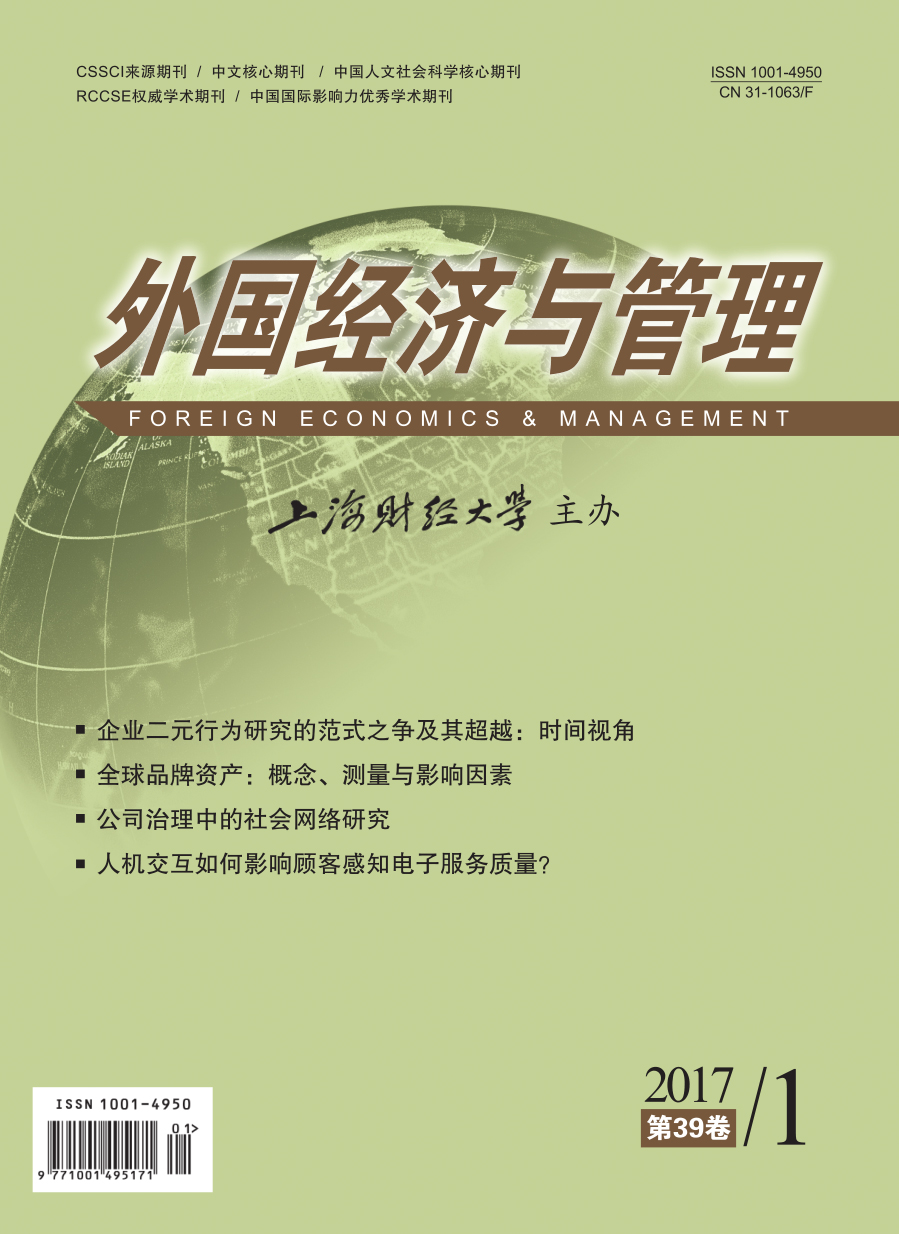人力资本的组织化即个体层面的知识、技能、能力等人力资本向组织层面人力资源的聚集和转化,这种聚集和转化过程使得组织化人力资本打上了组织的独特烙印,具有不可模仿和替代并且能够根据组织特定的战略目标进行动态调整的特征,构成了组织竞争优势的重要来源,能够为组织达成战略目标、实现价值增值做出贡献。本文在梳理了经济学、心理学、教育学和管理学对人力资本理论发展的研究贡献的基础上,系统归纳了组织化人力资本资源管理的理论框架与核心观点,侧重评介了人力资本在揭示战略人力资源管理及组织绩效提升“黑箱”机制中的作用研究,关注了组织人力资本池的构建及战略匹配与冗余机制,以及人力资本资源涌现与组织人力资本资源的转化及形成过程,并概括了研究启示和未来研究方向。
组织化人力资本研究探析与展望——基于战略管理的视角
摘要
参考文献
3 张正堂.战略人力资源管理研究[M].北京:商务印书馆, 2012.
4 Barney J. Firm resources and sustained competitive advantage[J]. Journal of Management, 1991, 17(1):99-120. DOI:10.1177/014920639101700108
5 Barney J B. Is the resource-based "view" a useful perspective for strategic management research? Yes[J]. Academy of Management Review, 2001, 26(1):41-56.
6 Becker B E, Huselid M A. Strategic human resources management:Where do we go from here?[J]. Journal of Management, 2006, 32(6):898-925. DOI:10.1177/0149206306293668
7 Chatterjee S, Wernerfelt B. The link between resources and type of diversification:Theory and evidence[J]. Strategic Management Journal, 1991, 12(1):33-48. DOI:10.1002/(ISSN)1097-0266
8 Cockburn I M, Henderson R M, Stern S. Untangling the origins of competitive advantage[J]. Strategic Management Journal, 2000, 21(10-11):1123-1145. DOI:10.1002/(ISSN)1097-0266
9 Coff R W. Human assets and management dilemmas:Coping with hazards on the road to resource-based theory[J]. Academy of Management Review, 1997, 22(2):374-402.
10 Coff R W. Human capital, shared expertise, and the likelihood of impasse in corporate acquisitions[J]. Journal of Management, 2002, 28(1):107-128. DOI:10.1177/014920630202800107
11 Coff R, Kryscynski D. Drilling for micro-foundations of human capital-based competitive advantages[J]. Journal of Management, 2011, 37(5):1429-1443. DOI:10.1177/0149206310397772
12 Crook T R, Todd S Y, Combs J G, et al. Does human capital matter? A meta-analysis of the relationship between human capital and firm performance[J]. Journal of Applied Psychology, 2011, 96(3):443-456. DOI:10.1037/a0022147
13 Eisenhardt K M, Martin J A. Dynamic capabilities:What are they?[J]. Strategic Management Journal, 2000, 21(10-11):1105-1121. DOI:10.1002/(ISSN)1097-0266
14 Hatch N W, Dyer J H. Human capital and learning as a source of sustainable competitive advantage[J]. Strategic Management Journal, 2004, 25(12):1155-1178. DOI:10.1002/(ISSN)1097-0266
15 Hitt M A, Biermant L, Shimizu K, et al. Direct and moderating effects of human capital on strategy and performance in professional service firms:A resource-based perspective[J]. Academy of Management Journal, 2001, 44(1):13-28. DOI:10.2307/3069334
16 Huang C C. Human capital investment system, innovation strategy and organizational performance-many fit views[J]. Journal of Management, 2003, 22(1):99-126.
17 Hult G T M, Ketchen Jr D J, Nichols Jr E L, et al. Organizational learning as a strategic resource in supply management[J]. Journal of Operations Management, 2003, 21(5):541-556. DOI:10.1016/j.jom.2003.02.001
18 Kor Y Y, Leblebici H. How do interdependencies among human-capital deployment, development, and diversification strategies affect firms' financial performance?[J]. Strategic Management Journal, 2005, 26(10):967-985. DOI:10.1002/(ISSN)1097-0266
19 Kozlowski S W J, Klein K J. A multilevel approach to theory and research in organizations:Contextual, temporal, and emergent processes[A]. Klein K J, Kozlowski S W J (Eds.). Multilevel theory, research, and methods in organizations:Foundations, extensions, and new directions[C]. San Francisco, C A:Jossey-Bass, 2000:3-90.
20 Kwon K, Rupp D E. High-performer turnover and firm performance:The moderating role of human capital investment and firm reputation[J]. Journal of Organizational Behavior, 2013, 34(1):129-150. DOI:10.1002/job.1804
21 Lado A A, Wilson M C. Human resource systems and sustained competitive advantage:A competency-based perspective[J]. Academy of Management Review, 1994, 19(4):699-727.
22 Lepak D P, Snell S A. The human resource architecture:Toward a theory of human capital allocation and development[J]. Academy of Management Review, 1999, 24(1):31-48.
23 Lepak D P, Takeuchi R, Snell S A. Employment flexibility and firm performance:Examining the interaction effects of employment mode, environmental dynamism, and technological intensity[J]. Journal of Management, 2003, 29(5):681-703. DOI:10.1016/S0149-2063(03)00031-X
24 Liao H, Chuang A. A multilevel investigation of factors influencing employee service performance and customer outcomes[J]. Academy of Management Journal, 2004, 47(1):41-58. DOI:10.2307/20159559
25 Macduffie J P. Human resource bundles and manufacturing performance:Organizational logic and flexible production systems in the world auto industry[J]. Industrial and Labor Relations Review, 1995, 48(2):197-221. DOI:10.1177/001979399504800201
26 Nyberg A J, Wright P M. 50 years of human capital research:Assessing what we know, exploring where we go[J]. Academy of Management Perspectives, 2015, 29(3):287-295. DOI:10.5465/amp.2014.0113
27 Pfeffer J. Fighting the war for talent is hazardous to your organization's health[J]. Organizational Dynamics, 2001, 29(4):248-259. DOI:10.1016/S0090-2616(01)00031-6
28 Ployhart R E, Weekley J A, Baughman K. The structure and function of human capital emergence:A multilevel examination of the attraction-selection-attrition model[J]. Academy of Management Journal, 2006, 49(4):661-677. DOI:10.5465/AMJ.2006.22083023
29 Ployhart R E, Weekley J A, Ramsey J. The consequences of human resource stocks and flows:A longitudinal examination of unit service orientation and unit effectiveness[J]. Academy of Management Journal, 2009, 52(5):996-1015. DOI:10.5465/AMJ.2009.44635041
30 Ployhart R E, Moliterno T P. Emergence of the human capital resource:A multilevel model[J]. Academy of Management Review, 2011, 36(1):127-150.
31 Ployhart R E, Nyberg A J, Reilly G, et al. Human capital is dead; long live human capital resources![J]. Journal of Management, 2014, 40(2):371-398. DOI:10.1177/0149206313512152
32 Ployhart R E, HaleJr D. The fascinating psychological microfoundations of strategy and competitive advantage[J]. Annual Review of Organizational Psychology and Organizational Behavior, 2014, 1:145-172. DOI:10.1146/annurev-orgpsych-031413-091312
33 Schmidt J, Keil T. What makes a resource valuable? Identifying the drivers of firm-idiosyncratic resource value[J]. Academy of Management Review, 2013, 38(2):206-228. DOI:10.5465/amr.2010.0404
34 Teece D, Pisano G. The dynamic capabilities of firms:An introduction[J]. Industrial and Corporate Change, 1994, 3(3):537-556.
35 Teece D J, Pisano G, Shuen A. Dynamic capabilities and strategic management[J]. Strategic Management Journal, 1997, 18(7):509-533. DOI:10.1002/(ISSN)1097-0266
36 Wright P M, Dunford B B, Snell S A. Human resources and the resource based view of the firm[J]. Journal of Management, 2001, 27(6):701-721. DOI:10.1177/014920630102700607
37 Wright P M, Boswell W R. Desegregating HRM:A review and synthesis of micro and macro human resource management research[J]. Journal of Management, 2002, 28(3):247-276. DOI:10.1177/014920630202800302
38 Wright P M, McMahan G C. Exploring human capital:Putting "human" back into strategic human resource management[J]. Human Resource Management Journal, 2011, 21(2):93-104. DOI:10.1111/hrmj.2011.21.issue-2
39 Wright P M, Coff R, Moliterno T P. Strategic human capital:Crossing the great divide[J]. Journal of Management, 2014, 40(2):353-370. DOI:10.1177/0149206313518437
40 Youndt M A, Snell S A. Human resource configurations, intellectual capital, and organizational performance[J]. Journal of Managerial Issues, 2004, 16(3):337-360.
引用本文
李新建, 李懿, 魏海波. 组织化人力资本研究探析与展望——基于战略管理的视角[J]. 外国经济与管理, 2017, 39(1): 42–55.
导出参考文献,格式为:
下一篇:信息化人力资源管理研究进展探析





 9283
9283  12357
12357

